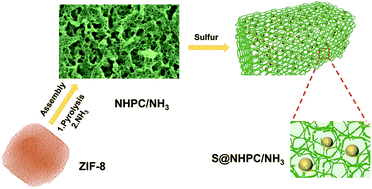Transformation of ZIF-8 nanoparticles into 3D nitrogen-doped hierarchically porous carbon for Li–S batteries†
Abstract
Li–S batteries have been attracting increasing interest owing to their remarkable advantages of low cost, high theoretical capacity and high theoretical energy density. Nevertheless, the severe “shuttle effects” of lithium polysulfides have markedly limited the performance of the cells and further hindered their commercial applications. Herein, a novel scheme combining a transformation strategy with ammonia treatment was developed to fabricate ZIF-8-derived nitrogen-doped hierarchically porous carbon (NHPC/NH3). When NHPC/NH3 was used as a host of sulfur, the obtained S@NHPC/NH3 cathode for Li–S cells presented an initial specific capacity of 1654 mA h g−1 and an outstanding cycling stability with only 0.27% attenuation per cycle from the 30th cycle to 130th cycle. Together with the theoretical calculation, it was concluded that such excellent electrochemical performances should be attributed to the suppressed “shuttle effect” via both physical and chemical adsorption of lithium polysulfides in the optimized microporous structures with effective nitrogen doping sites as well as the improved kinetics owing to the abundant meso/macroporous structures.



 Please wait while we load your content...
Please wait while we load your content...